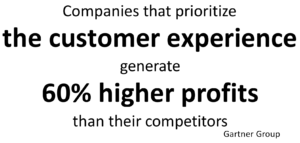Overview
Earlier this week, I released a short video about Customer Journey Management and its benefits for organizations, with examples from Amazon, Starbucks, Uber, Netflix, Apple, and the Financial Sector. (see the 4 minutes on YT: https://youtu.be/an5tNYXXzHo)
Wow, what a response. I didn’t expect that.
Many folks have tried and failed to deploy Customer Journey Map approaches effectively.
Here’s a summary of some of the five most significant challenges. In another article, we will discuss how to avoid them based on the best practices of those who have delivered success.
Some significant drawbacks can affect a company’s ability to provide a great experience to its customers.
🤝Customer Needs
One of these issues is a need for insight into the customer’s needs and desires. This can create an inconsistency between their services and products and the customer’s expectations, leading to disappointment and exasperation.
💖Personalization
Furthermore, not offering a personalized experience make customers feel disregarded and unappreciated.
🎸Co-ordination
Additionally, a failure to properly coordinate and integrate different channels and touchpoints can lead to an incoherent journey for the customer, making it difficult for them to get the assistance or data they require.
🏢Structural challenges
A hindrance is silo-based thinking; when a business has several separate systems and processes, it can take time to get a comprehensive outlook on the customer’s experience and to determine their path.
This can make it challenging to find and address any issues or areas that need to be improved.
✍️Connecting the dots
Understanding the link between internal operations, data, and customer experience is essential. By being aware of the overall process customers go through when interacting with an organization, and the systems and processes that back them, CX professionals can pinpoint pain points and chances for optimization within the customer journey.
Additionally, it is essential to remember that CJM is not a single-time task but rather an ongoing effort to be evaluated and updated routinely. It calls for the participation and collaboration of all levels of the organization. It serves to align initiatives from various departments to upgrade the customer experience and positively affect the business.
Conclusion:
Several specific actions will reduce the risk of poor CJM implementation. We will discuss those shortly by reviewing the best practices of companies that have delivered success.
If you want the inside track on that, subscribe and share this blog.
RECOMMENDED QUALIFICATION:
The Accredited Customer Experience Professional® (ACXP): https://bit.ly/GCCACXP
If you want to check if your colleagues are already qualified do a search with #ACXP on Linkedin.
Learn more about CJM plus as practiced within the CEMMethod: https://www.cemmethod.com
Connect with the author: https://linktr.ee/SteveTowers




 This isn’t rocket science (unless you are NASA of course). Understanding that the structures and ways of working from the industrial age were NEVER designed to be customer-centric. They were established to make things faster by optimizing production lines.
This isn’t rocket science (unless you are NASA of course). Understanding that the structures and ways of working from the industrial age were NEVER designed to be customer-centric. They were established to make things faster by optimizing production lines.